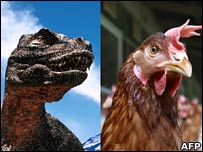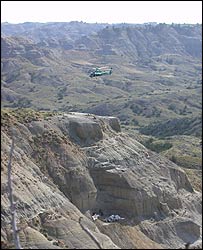|
By Paul Rincon
Science reporter, BBC News
|

Protein extracted from 68 million-year-old T. rex bones has shed new light on the evolutionary link between dinosaurs and birds.
Researchers compared organic molecules preserved in the T. rex fossils with those of living animals, and found they were similar to chicken protein.
The discovery of protein in dinosaur bones is a surprise - organic material was not thought to survive this long.
A US team of researchers have published the finding in Science journal.
The team says their technique could help reveal evolutionary relationships between other living and extinct organisms.
The finding is consistent with the idea that birds can trace a direct evolutionary line to dinosaurs.

The resemblance may not be immediately obvious
|
The proteins are original organic material from the dinosaur's soft tissue, and not contamination, the scientists argue.
According to theories of fossilisation, original organic material is not thought to survive as long as this; finding them in a fossil this old is a genuine surprise. They are by far the oldest such molecules extracted from fossils.
"It has always been assumed that preservation of [dinosaur bones] does not extend to the cellular and molecular level," said co-author Mary Schweitzer, from North Carolina State University in Raleigh, US.
"The pathways of cellular decay are well known for modern organisms. And extrapolations predict that all organics are going to be gone completely in 100,000 years, maximum."
Brooks Hanson, an editor at Science journal said: "The goal of obtaining sequences either from proteins or DNA for extinct [organisms] has been a long-standing goal to test evolutionary links and processes, or even functional information."
The work builds on an earlier discovery of soft tissue - including blood vessels - by Dr Schweitzer's team in the same, incredibly well-preserved Tyrannosaurus rex fossils.
Exceptional preservation
The dinosaur remains - which include a skull, both thigh bones and both tibiae (shin bones) - were unearthed from rocks in the Hell Creek Formation of eastern Montana, US.
The fossils were buried under at least 1,000 cubic metres of loose sandstone, interspersed with muds, which are thought to represent ancient stream channel sediments.

The bones were buried under 1,000 cubic metres of rock in Montana
|
The proteins found in the T. rex bones belong to the elastic connective fibres - known as collagen - that support other tissues in the body.
Collagen makes up most of the organic material in bone, which consists of both minerals and protein. It is the same substance injected into the lips, and other areas of the body, in cosmetic surgery procedures.
When minerals are removed from human bone, a collagen matrix is left behind. The US scientists performed the same operation on the T.rex fossil, and found what appeared to be residual traces of collagen.
The findings of protein in the bones were confirmed by mass spectrometry, a sensitive technique that identifies chemicals by their atomic mass.
It was able to show the T.rex material contained sequences of amino acids - protein building blocks - typical of collagen.
Chicken-like
When the scientists compared the protein sequence pattern to those of living animals in a database, it was found to be structurally similar to chicken collagen, and there were also similarities with frog and newt protein.
Dr Schweitzer said the similarity to chickens was exactly what one would expect given the relationship between modern birds and dinosaurs."
Dr Jack Horner, a co-author from the Museum of the Rockies in Bozeman, Montana, explained that extraordinarily well-preserved fossils such as the ones in question were probably not unique.
"To get specimens like that involves excavating enormous amounts of material, covered with tens of feet of rock," Dr Horner said.
"The T.rex was under a thousand cubic yards of rock and therefore in a position not to have been invaded by bacteria or groundwater," he said.
"I think we're learning an important lesson here - that if we do get specimens like this, we spend a lot of time getting as deep into the sediment as we can in places where there has been very little atmospheric or water contamination."
Dinosaurs, excluding bird lineages, disappeared from the face of the planet 65 million years ago. The reptiles are thought to have been killed off by an asteroid impact which struck off the present-day Yucatan peninsula in Mexico.


~RS~q~RS~~RS~z~RS~53~RS~)